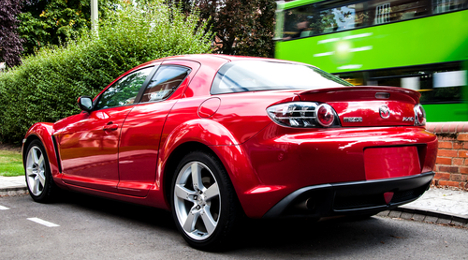As the group’s used-vehicle sales jumped by 10.6 percent in the U.S., the segment of Group 1 Automotive’s business that shined brightest during the first quarter was the finance and insurance department.
Delving into more U.S. results, F&I revenue jumped 13.3 percent while Group 1 established an F&I gross profit per unit record. That back-end gross climbed 5.5 percent or $80 to an all-time record of $1,538 per retail unit.
The record-setting gross performance in the F&I department helped to offset the slight dip in used retail gross Group 1 produced in the first quarter. The figure came in at $1,613 in Q1, off by 2 percent or $33 year-over-year.
However, group stores turned more used metal this past quarter, retailing 25,148 units. Group 1 also wholesaled more vehicles in Q1 as the total moved up by 6.0 percent to 10,544.
All of those activities combined to push the company's U.S. revenues to $2.0 billion, an increase of 8.9 percent. The revenue growth reflects unit sales increases of 5.0 percent in new vehicles as well as an increase of 5.5 percent in parts and service revenue.
Group 1 highlighted this strong sales performance drove gross profit growth of 8.5 percent, reflecting the higher new and used retail volumes, and an increase of SG&A expenses as a percent of gross profit improved 160 basis points to 73.1 percent and operating margin improved 20 basis points to 3.7 percent.
The company’s U.S. operations accounted for 82.2 percent of total revenues and 86.4 percent of total gross profit.
Adding in the performance of enterprises in the U.K. and Brazil, Group 1 reported first quarter net income of $35.8 million, a 14.4-percent increase, and record first quarter diluted earnings per common share of $1.47, a 23.5-percent increase, on a year-over-year basis.
“We are pleased with our first quarter record earnings driven by strong top-line growth in the United States and the United Kingdom,” Group 1 president and chief executive officer Earl Hesterberg said.
“Contrary to the widespread concern about the impact of lower oil prices on our business, our improvements were led by double-digit same-store new vehicle growth from our dealerships in Houston and along the Gulf Coast,” Hesterberg continued. “We continue to monitor local market conditions and remain prepared to act if we see any signs of weakening, but to date, sales are holding up in our oil-impacted markets.”
In regards to the company’s Brazilian operations, Hesterberg added, “As expected, the Brazilian auto industry had a weak start to 2015 due to tax changes and overall economic issues. However, our Brazilian team outperformed the market throughout the quarter and almost achieved financial breakeven.
“Although we generated a slight loss in Q1, we expect to be profitable in Brazil this year,” he went on to say.
Penske Automotive Group announced its earnings results for the first quarter of this year and held its quarterly conference call Tuesday.
The company sold a total of 48,057 used retail units (U.S. and international) in the first quarter, representing a year-over-year increase of 6.7 percent.
Sharing more overall pre-owned results, Penske's used-vehicle revenue rose 6.8 percent year-over-year, up to roughly $1.28 billion.
Gross profit for used vehicles fell to $84.5 million, a 2.3 percent year-over-year decrease.
Gross profit per used vehicle retailed was down 8.5 percent year-over-year to $1,758.
Roger Penske, the group’s chairman, commented on the company’s successes as well as the effect of the strengthening U.S. dollar in addition to issues outside of the U.S.
"I am very pleased with the performance of our overall business in the first quarter," Penske said. "Our retail automotive and U.S.-based commercial truck businesses continue to perform very well as our business posted record first quarter unit sales, revenue, income from continuing operations, and earnings per share performance. We look for the strength in these parts of our business to continue.
“However, in addition to the impact from exchange rates in the quarter, the challenging economic conditions faced by our Australian commercial vehicle distribution business resulted in a year-over-year decline of approximately $0.04 in earnings per share as the Australian heavy-duty truck market declined 14.3% in the first quarter of 2015."
For a complete listing of Penske’s first quarter results, click here.
AutoNation hosted a conference call on Wednesday to recap its first-quarter performance, which was highlighted by a record Q1 earnings per share from continuing operations of $0.97, a 29-percent increase compared to 2014, as well as year-over-year net income gains and total revenue increases.
But perhaps a more telling note was spoken by the company’s chairman, chief executive officer and president, Mike Jackson, in regards to recalls, where he expressed dissatisfaction with the overall process of how they have been handled.
When asked if the market should expect the rate of recalls to remain high in the future and increase in perpetuity, Jackson’s not convinced they'll continue to be as large as they have been in the past, but he’s also not happy with the current process of how they are dealt with.
“I think it probably will be high, but whether it’s this high, I’m not convinced at all,” Jackson said. “These are two extraordinary recalls that are so broad and so old that to say we’re going to have these type of recalls, open-ended, I’m not necessarily there. But I think the feeling within the industry is, if in doubt, recall; recall the sooner the better.
“And certainly the whole process, somehow, some way, needs to be improved. It’s really broken the way it is today, almost dysfunctional. We get it all done at the end of the day, but it’s certainly not ideal, and certainly, the customers deserve something better than what’s going on today. But to say we’re going to be open-ended at this level I wouldn’t necessarily agree with that.”
According to AutoNation’s executive vice president and chief operating officer, Bill Berman, recalls represent 5.2 percent of the company’s customer care gross profit, which Jackson estimates to be roughly 25 percent of the increase in customer care gross profit since the spike in recalls began.
The two “extraordinary” recalls that Jackson mentioned are the company’s largest, the General Motors ignition switch recall and the Takata airbag recall. According to Berman, the company has repaired roughly 23,000 GM ignition switches and 48,000 Takata airbags. These repairs account for 60 percent (GM) and 20 percent (Takata), respectively, of the vehicles AutoNation would reasonably expect to execute based on retail sales history and industry standard completion rates, the company said.
Separately, discussing the acquisition front, Jackson also hinted that there are a lot of conversations ongoing, but didn’t want to nail down any sort of commitment to expansion until the deals were done.
“I think it’s fair to say that there is a lot of activity and a lot of discussion underway from willing sellers,” Jackson said. “And we’ll see if that leads to transactions.”
For a full listing of AutoNation's first-quarter results, click here.
One figure appeared four different times when Lithia Motors reported the highest first-quarter adjusted net income in company history on Wednesday. Lithia enjoyed 11-percent increases in four major performance categories, including:
— Used-vehicle retail same-store sales
— New-vehicle same-store sales
—Total same-store sales
—Service, body and parts same-store sales
The Q1 performance of those four dealer business areas helped to propel Lithia to an increase in adjusted net income from continuing operations of 36 percent compared to the prior-year period. That adjusted net income from continuing operations figure came in at $36.9 million, or $1.39 per diluted share, up from $27.1 million, or $1.03 per diluted share, a year earlier.
The company’s first-quarter revenue soared $711 million (or 66-percent) higher to $1.8 billion, up from $1.1 billion in the same period last year.
Now with DCH Auto stores in the Lithia portfolio, the dealer group’s sales figures are significantly higher year-over-year. Here are some of the highlights in connection with the used and F&I departments and year-over-year comparisons:
— Used retail unit sales: 24,204, up by 7,888 vehicles (or 48.3 percent)
— Average used-vehicle selling price: $19,126, up $623 (or 3.4 percent)
— Average gross profit per used-vehicle retail sale: $2,456, down $44 (or 1.8 percent)
— Finance and insurance gross profit per retail sale: $1,178, down $2 (or 0.2 percent)
On a same-store basis, Lithia pointed out that F&I per unit increased $52 to $1,233. The company added that adjusted SG&A expense as a percentage of gross profit came in at 71.3 percent
"We delivered the best first quarter earnings in our company’s history, and the second best quarterly earnings ever,” Lithia president and chief executive officer Bryan DeBoer said.
“For the fourth consecutive quarter, we achieved double-digit growth in same-store sales in all business lines,” DeBoer continued. “On a continuing operations basis, we grew revenue 66 percent and adjusted net income 36 percent over the first quarter of 2014.
“We remain focused on capturing additional market share, improving existing store results, the continued success, integration and growth of DCH and actively seeking accretive acquisitions,” he went on to say.
Senior vice president and chief financial officer Chris Holzshu noted SG&A as a percentage of gross profit ended up slightly higher than the prior year due to the effect of Lithia’s DCH acquisition and better than the company’s projection.
“We target improving SG&A as a percentage of gross profit as we integrate the 36 stores added in 2014,” Holzshu said.
“In the first quarter, incremental throughput, or the percentage of additional same store gross profit dollars that we retain after deducting incremental selling costs, was 45.1 percent,” he continued.
“Our stores remain focused on maintaining incremental throughput of 45 percent to 50 percent, which will continue to lever our SG&A expense going forward,” Holzshu added.
Editor’s Note: For Lithia’s perspective on how increased wholesale supply is going to enhance its used-vehicle performance during the next year and beyond, be sure to watch for Monday’s edition of Auto Remarketing Today.
According to the latest numbers provided by the National Auto Auction Association, auction volume is up nearly 7 percent year-to-date against comparable weeks of 2014.
The latest Economic Dashboard, prepared by NAAA economist Ira Silver and posted to the association’s website earlier this month, said year-to-date auction volume climbed 6.9 percent through three months of the year, with auction volume in March, specifically, up 4.5 percent.
On the retail side, that same report indicates that new-car sales are beating year-ago figures by 6 percent through three months.
Meanwhile, used retail sales seemed steady on both a monthly and year-to-date basis in March, says Manheim chief economist Tom Webb.
“Dealers retailing units in the $18,000 and above range did better than those selling lower-end units. CarMax posted a strong 7-percent increase in same-store retail used unit volumes and an average transaction price of $19,297 for their fiscal quarter ending February 28,” Webb said in the latest Manheim Used Vehicle Value Index report. “Manufacturer CPO sales also continued their record pace, up 8 percent in March and 11 percent year-to-date.”
Webb added: “Dealers selling lower-priced units were likely hampered by a less-than-stellar tax refund season. Since the start of February, the level of tax refunds has fallen below the year-ago amount in seven out of eight weeks. Through March, total refunds were down 1.1 percent, or $2.3 billion, from a year ago.”
CarMax’s in-house auction arm, whose fiscal year ended Feb. 28, recently accomplished something it had never done before — it exceeded $1,000 in profit, per wholesale vehicle, in its fourth quarter. To be exact, the wholesale vehicle gross profit for the quarter was $1,036, a roughly 9-percent year-over-year increase.
When asked what fueled that kind of profitability in Q4, CarMax’s president and chief executive officer, Tom Folliard, attributed the result to “execution.”
“Really good execution continues to build year over year,” Folliard said. “It’s the first fourth quarter we’ve ever had that exceeded $1,000 in profit per car. We’ve had two first quarters that have done that in the past but as our reputation builds as a great place for dealers to come and buy this type of product,
“I think our stores do a great job of marketing and it’s always a balancing act between wholesale margin and making sure we have a very strong buy rate,” he added. "Remember lots of these customers that are selling these cars are also buying a car from us. So a good barometer for how fair we’re being with our customers is our buy rate.”
And that buy rate, 30 percent, is a figure Folliard considered “very strong.” He also said it’s always a challenge to maintain a balance between the wholesale and retail business.
“It’s never a standalone business that can be managed separately,” Folliard said. “You always have to pay attention to what’s happening on the retail side. I’m really proud of the stores and how well they’ve executed. We have some stores that are particularly tight on space and … some stores are running two auctions a week now, out in California. The stores have done a fantastic job of managing relationships and making sure we get great attendance. That’s led to great performance.”
That performance is easily apparent. To provide some overall context, CarMax retailed 582,282 used vehicles in its fiscal year ending on Feb. 28. In that same time, CarMax Auctions sold 376,186 wholesale units solely at its in-store auctions, selling only vehicles it owns, to licensed dealers.
The effects of a recall can do quite a bit more harm to a vehicle’s image than the immediate problems they typically cause – they can also dramatically accelerate their rate of value depreciation.
That’s according to the analysts at iSeeCars.com, who recently released the results of a study they conducted to see the effect of a specific situation, the Takata airbag recall, on the depreciation rate of the vehicles they were in.
Their findings are staggering – according to their results, based on an analysis of over 19 million used vehicles including vehicles recalled for potential issues with Takata airbags and comparable, unaffected models, the affected vehicles saw an average of 2.2 times higher price drops than vehicles not under the airbag recall.
Based on data during the recall period, from Oct. 2014 to Feb. 2015, Takata-affected vehicles saw a price decline of 7.1 percent year-over-year, compared to a 3.2 percent decline in price for vehicles not affected.
“It seems like the dramatic risk of injury associated with these defective airbags may have led to a decrease in perceived value,” said Phong Ly, iSeeCars.com’s chief executive officer. “Since most consumers trade in their cars rather than sell them privately, it means they’re getting hit even harder on their trade-in values.”
The study also narrowed its focus to identify the individual vehicles hit hardest by these perceptions, noticing that the average price decline for the top-10 models ranged from 1.3 to 3.5 times more than the average decline for similar vehicles not subject to the same recall. Here is that list, provided by iSeeCars.com.
10 Takata-Recalled Cars With the Biggest Price Drops
|
Rank
|
Takata-Affected Model
|
Model Years
|
% Avg Price Change YOY
|
% Avg Price Change YOY
for Similar Cars
|
Price Drop Compared With Similar Cars
|
|
1
|
Mazda RX-8
|
2004–2008
|
−12.0%
|
−3.4%
|
3.5x Greater
|
|
2
|
Infiniti FX35/45
|
2003–2005
|
−13.0%
|
−5.1%
|
2.6x
|
|
3
|
BMW 3 Series*
|
2000–2006
|
−13.4%
|
−7.1%
|
1.9x
|
|
4
|
Dodge Dakota
|
2005–2008
|
−7.2%
|
−4.0%
|
1.8x
|
|
5
|
Toyota Tundra
|
2003–2005
|
−7.5%
|
−4.9%
|
1.5x
|
|
6
|
Nissan Maxima
|
2001–2003
|
−12.5%
|
−8.8%
|
1.4x
|
|
7
|
Honda CR-V
|
2002–2006
|
−11.6%
|
−8.8%
|
1.3x
|
|
8
|
BMW M3
|
2001–2006
|
−9.2%
|
−7.0%
|
1.3x
|
|
9
|
Dodge Durango
|
2005–2008
|
−11.6%
|
−9.1%
|
1.3x
|
|
10
|
Honda Pilot
|
2003–2007
|
−11.5%
|
−9.1%
|
1.3x
|
* Coupe and convertible.
CarMax hosted its quarterly conference call today, highlighting several company feats, including an increase in comparable-store used unit sales of 7 percent in its fiscal fourth quarter that ended Feb. 28, as well as an increase of that same metric for the year at 4.4 percent.
Total used unit sales were up 12.4 percent in the fourth quarter and 10.5 percent for the year, bolstered by the company’s acquisition of 18 stores since the fourth quarter of 2013. Tom Folliard, CarMax’s president and chief executive officer, said that the company plans to between 13 and 16 stores in each of the next three fiscal years.
“We had another great year, achieving several new milestones,” Folliard said. “Since opening our first store in 1993, we’ve now retailed well over 5 million used cars and 3 million wholesale cars, which is a testament to the strength of our brand. In fiscal 2015, the continued strong performance of our used, wholesale and CAF operations, along with the growth of our store base and our ongoing share repurchase program, contributed to our record earnings per share.”
And those earnings per share were staggering — net earnings per diluted share rose 52.3 percent to $0.67 per share in the fourth quarter while those same metrics grew 26.4 percent for the fiscal year, up to $2.73 per share.
On the wholesale front, total unit sales increased 12.3 percent in the fourth quarter and 9.8 percent for the year.
A complete list of CarMax's 2014 results can be found here.
If a person age 35 or older bought a car from your dealership last year, chances are pretty good (68 percent) that car was used. If someone in the millennial generation bought a car from you, the odds that it was used are even higher.
According to a study from Edmunds.com, more than three-fourths (78 percent) of the vehicles that millennials bought last year were used.
The root of this, says Edmunds chief executive officer Avi Steinlauf, is largely the price-point. Millennials, he said, were hit the hardest by the recession, and it has been “a little bit tougher for them to rebound,” thus making the used vehicle a more attractive option.
But things eventually change.
“As they get older and their incomes increase, they start to mirror the broader population,” Steinlauf told Auto Remarketing in an interview Friday.
As for certified pre-owned, the study didn’t specifically ask millennials about this segment, but Steinlauf emphasized that the assurance and warranty offered by CPO programs would likely be appealing to those in this crowd that value such certifications.
Along those same lines, quality of the vehicle itself is important to millennials.
What often gets lost in the shuffle in media coverage of this generation and the importance of technology, Steinlauf says, is that millennials aren’t just in it for the tech and gadgets.
Granted, many certainly appreciate these features; looking at overall results, four-fifths of Generation Y put a strong emphasis on having smartphone features integrated into the car, and close to two-thirds (62 percent) would spend more if the car was Wi-Fi connected.
But the study found that price, fuel economy and performance rank much higher than in-car technology
Or as Steinlauf put it, millennials “have their priorities straight.”
Here’s another statistic from Edmunds’ study that sticks out: 39 percent of all used-car pages on Edmunds.com was from millennial shoppers. But if you look at the mobile traffic to those same pre-owned pages, close to three-fifths (58 percent) came from millennials.
What that boils down to is that it’s another “manifestation” of the penchant millennials have for using mobile devices. In fact, 54 percent of mobile traffic overall came from millennials, Steinlauf said.
“They over-index in utilizing mobile technology and accessing our information that way,” he said.
Roughly a third of millennials used their phones to find contact information for local dealerships, versus a fourth of folks who are 35 or older. Likewise, 70 percent of car buyers in Gen Y texted with a dealer during the shopping process; only 43 percent of all other adults did the same.
It may sound like a broken record that the discussion of automotive technicians has once again surfaced in one of the largest auto group’s quarterly conference calls.
But Lithia Motors president and chief executive officer Bryan DeBoer touched on another interesting angle regarding how fuel prices affect the automotive industry — the service side.
When asked how the lowering fuel prices affected Lithia’s sales in fuel-producing states, DeBoer said his company is seeing a bit of a “yin-and-yang benefit."
“In Q4, I think what we really saw was a mix shift from new vehicles to used vehicles. The oil states performed slightly lower than the rest of our states in Q4,” DeBoer said. “If you want a little more color of what’s happening in January — Alaska was up 28 percent year over year in total revenues. North Dakota, which is highly based energy state, even though we’re (selling) in the eastern part of the state, was up 4 percent. And Texas was up about 3 (percent), which is a little bit behind. It still seems strong, though, we’re still pleased.
“It’s a robust economy, there’s no question about it. And if there’s one thing we could say is an opportunity (it's that) some of those pump jacks are now not running, which means that those technicians that aren’t fixing the broken ones are coming back into our company and can now fix the cars that are now in service,” DeBoer continued, “which we all know the throughput in service in cars is a much higher rate than what it is in new vehicles and used-vehicles sales.”
Lithia experienced a 12-percent growth in service, body and parts sales on a same-store basis in Q4 of 2014, which DeBoer said was by no means an unexpected jump and should be expected to increase further in the future. When asked what prompted the strong growth in service sales, DeBoer pointed to an increase in customers simply choosing to come back to Lithia for work on vehicles they had purchased from the company.
“It’s primarily driven solely off of units in operation,” DeBoer said. “Despite us being up 12 percent in aggregate in fixed operations — yeah, it’s (sales) driven off warranty, and it’s driven off customer pay — primarily still we have probably half of our stores that are considerably below that 12-percent level (in service sale growth) and that haven’t reinvented themselves to be able to attract our consumers back to our stores and be able to meet their needs when it comes to a cost proposition or a time proposition.
“To us, 12 percent is just keeping pace with the units in operation growth,” DeBoer later continued.
For DeBoer, he thinks his company can still do better when it comes to convincing customers to bring their vehicles back for service.
“We believe that there’s still a lot of opportunity out there within our existing Lithia stores," he concluded.












